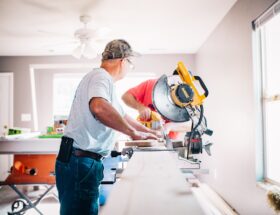As a homeowner, you always look for ways to save money on your monthly bills. Your water bill is no exception. With the latest advancements in plumbing technology, there are several ways you can reduce your water usage and save money on your water bill. In this post, we’ll explore some of the most effective plumbing technologies that can help you save money on your water bill. If any of them pique your interest, contact a local plumber to discuss your options!
Low-Flow Toilets
Toilets are one of the most significant sources of water usage in a household. According to the Environmental Protection Agency (EPA), older toilets can use up to 7 gallons per flush, while newer low-flow toilets use only 1.6 gallons or less. By upgrading to a low-flow toilet, you can save up to 20% on your water bill. Low-flow toilets are designed to use less water while still effectively flushing waste down the drain.
When choosing a low-flow toilet, you have two main options: single flush and dual-flush. Single-flush toilets use the same amount of water for every flush, while dual-flush toilets allow you to choose between a lower and higher water volume flush, depending on the waste being flushed. Dual-flush toilets can save even more water than single-flush toilets, especially if you have a larger household.
Another consideration when choosing a low-flow toilet is the type of flush mechanism. Pressure-assisted toilets use compressed air to flush waste, while gravity-assisted toilets use the natural force of gravity to flush waste. Pressure-assisted toilets tend to be more powerful and efficient, but they can also be louder and more expensive than gravity-assisted toilets.
High-Efficiency Showerheads
A standard showerhead uses around 2.5 gallons of water per minute. However, high-efficiency showerheads can use as little as 1.5 gallons per minute. This means that by switching to a high-efficiency showerhead, you can reduce your water usage by 40% or more. Additionally, high-efficiency showerheads provide an equal or better showering experience than standard showerheads.
When choosing a high-efficiency showerhead, look for models with the WaterSense label. WaterSense is a program sponsored by the EPA that certifies products that meet water efficiency and performance criteria. WaterSense-labeled showerheads use no more than 2.0 gallons per minute and provide a satisfying shower experience.
Some high-efficiency showerheads also include features like adjustable spray patterns and pause buttons, which can further reduce water usage while still providing a comfortable shower experience.
Faucet Aerators
Faucet aerators are small devices that attach to the end of your faucets. They mix air with water to reduce water flow while still maintaining adequate water pressure. This can reduce water usage by up to 30%. Faucet aerators are inexpensive and easy to install, making them an easy way to save money on your water bill.
When choosing a faucet aerator, consider the flow rate. Most aerators have a flow rate of 1.5 gallons per minute or less, but some models can go as low as 0.5 gallons per minute. A lower flow rate will save more water, but it may also reduce water pressure.
You should also consider the type of faucet you have when choosing a faucet aerator. Some faucets have a male thread on the inside, while others have a female thread on the outside. Make sure to choose an aerator that matches your faucet’s thread type.
Tankless Water Heaters
Traditional water heaters keep a large tank of water hot and ready for use at all times. This means that they’re constantly using energy to maintain the water temperature, even when they are not using hot water. Tankless water heaters, on the other hand, only heat water when it’s needed. This can save a significant amount of energy and water, as you’re not constantly heating and reheating water that’s not being used.
Tankless water heaters also have a longer lifespan than traditional water heaters. While traditional water heaters typically last around 10-15 years, tankless water heaters can last up to 20 years or more with proper maintenance. This means that not only will you save money on your water and energy bills, but you’ll also save money on replacement costs in the long run.
Leak Detection Systems
Even small leaks in your plumbing system can add up over time, resulting in wasted water and higher water bills. Leak detection systems can help you quickly identify and fix leaks before they become a significant problem. There are several types of leak detection systems available, including water alarms, moisture sensors, and flow sensors.
Water alarms are simple devices that sound an alarm when they detect water. They’re typically placed near water sources like sinks, toilets, and water heaters. Moisture sensors are more advanced devices that can detect water leaks before they become visible. They’re often installed in areas like basements, attics, and crawl spaces.
Flow sensors monitor your water usage and can detect unusual spikes or drops in water usage, indicating a leak. They’re typically installed near your water main or other critical water supply lines.
By investing in a leak detection system, you can catch leaks early and avoid costly repairs and wasted water.
What this means for you
by implementing the latest plumbing technologies, you can significantly reduce your water usage and save money on your water bill. Low-flow toilets, high-efficiency showerheads, faucet aerators, tankless water heaters, and smart irrigation systems are all effective ways to reduce your water usage without sacrificing performance or convenience. If you’re interested in implementing these technologies in your home, contact a licensed plumber to discuss your options. Don’t forget, regular drain cleaning can also help maintain the plumbing system’s efficiency, saving you even more money on your water bill over time.
Don’t hesitate to reach out to a professional plumber to help you select and install the right plumbing technologies for your home. With their expertise and experience, they can help you make the best decisions to save money and protect the environment.










